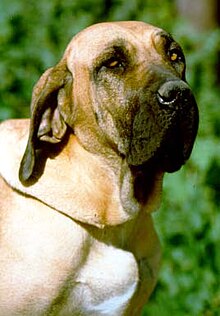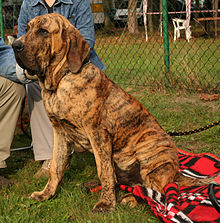Fila Brasileiro: Difference between revisions
| Line 54: | Line 54: | ||
*[http://www.filarescue.org Official Fila Rescue website] |
*[http://www.filarescue.org Official Fila Rescue website] |
||
*[http://e.webring.com/hub?ring=filaring Fila Brasileiro Webring] |
*[http://e.webring.com/hub?ring=filaring Fila Brasileiro Webring] |
||
*[http://members.boardhost.com/filabrasileiro/ Fila Brasileiro Message Board] |
|||
Revision as of 00:36, 22 December 2008
| Fila Brasileiro | |
|---|---|
 Fila Brasileiro | |
| Other names | Brazilian Mastiff Cão de Fila |
| Common nicknames | Fila |
| Origin | |
| Dog (domestic dog) | |
The Fila Brasileiro (or Brazilian Mastiff) is a large working breed of dog developed in Brazil.
Appearance
The Fila Brasileiro is a Molosser breed with large bones and loose skin. The breed standard requires males to be between 65 and 75 cm (27 - 29.5 in) high at the shoulder and weigh at least 50 kg (110 lb). Females are slightly smaller and expected to be 60 to 70 cm (24 - 27.5 in) tall, and weigh at least 40 kg (90 lb).
Coat
The coat of the Fila Brasileiro is smooth and short. Solid yellow, reddish tans, black and brindled colours are permitted, except mouse-grey and solid white. White markings, not exceeding 1/4 of the coat surface area, are permitted on the feet, chest, and the tip of the tail in the FCI/CBKC standard.
Temperament
This article contains weasel words: vague phrasing that often accompanies biased or unverifiable information. |
The Fila Brasileiro is an excellent estate guardian and cattle dog. It does not hide its dislike of strangers, consequently these dogs are not disqualified from the show ring for showing aggression to the judge [1]. Such aversion is instinctive in Filas, so much so that the Brazilian breed standard advises show judges not to touch the dog. [2] However, the FCI standard allows for disqualification of very aggressive dogs. The breed is renowned for their faithfulness to family and friends, but this is not a breed for everyone. The Fila needs a confident, experienced, savvy owner who is aware of the breed's innate tendencies. Filas are not well suited to busy household which entertain many guests, as they do not interact well with strangers.
Filas bond strongly with their immediate families with show an extreme loyalty and protectiveness towards them. They live to protect their loved ones, including children and other pets. They will not readily accept strangers and need an extended introduction period to warm up to those they do not know, some Filas will never tolerate any stranger. As with all breeds, some bloodlines have more accommodating temperaments than others and more readily accept properly introduced strangers. Despite their aggression to that which is foreign they are excellent family dogs,known to play very well and accept a great deal of "abuse" from the children in their family.
History

The Fila Brasileiro is believed to have been developed from a number of breeds, predominantly the Mastiff, the Bulldog, and the Bloodhound (the last contributing to breed's loose skin). The Fila Brasileiros were found primarily on large plantations and cattle farms from where they originated. Reportedly, they are also excellent tracking dogs and were used to track Brazilian slaves and fugitives. Dr. Paulo Santos Cruz contributed largely in writing the breed standard and importing the fila from the farms to Sao Paulo. In the 1970s, due to political pressures from the dog world, the stud book was closed in Brazil. This led to the split of the Fila Brasileiro into two distinct bloodlines, often referred to by their registries, CBKC and CAFIB. CAFIB offers phenotypical evaluation and registration for unregistered dogs, in the hopes of preserving the working abilities of Fila Brasileiro dogs in remote regions of the country. In fact, In Sir Arthur Conan Doyle's Hound of Baskervilles, there is reason to believe this is the hound. The dogs owner originated in South America and it was described as a Mastiff Bloodhound
Legal Status
In the United Kingdom ,Israel and the Australian city of Brisbane it is illegal to own any of these dogs without specific exemption from a court.
